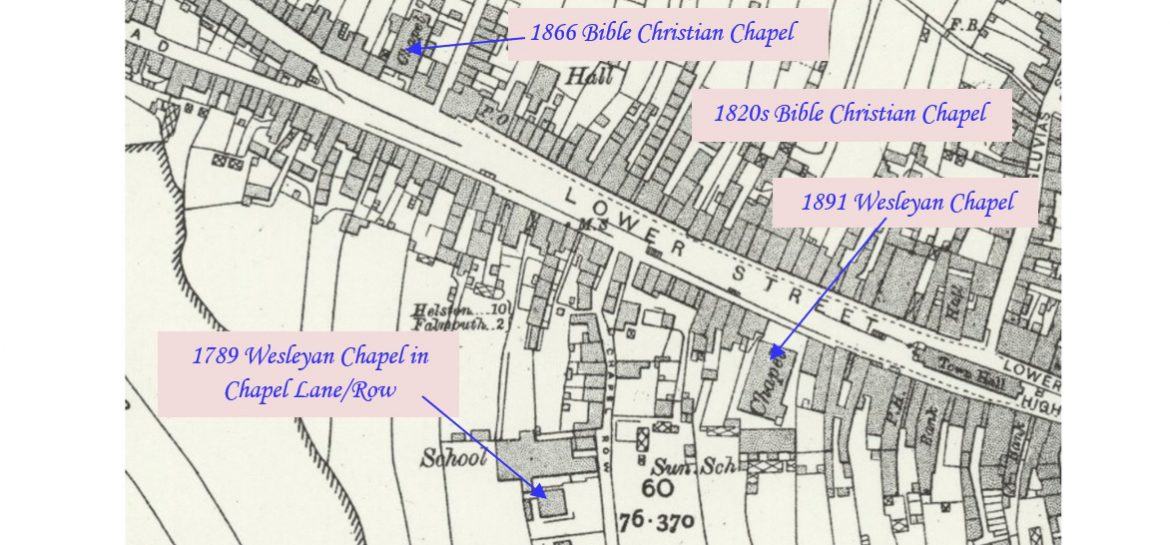
Penryn is a town on the Penryn River about one mile northwest of Falmouth. This profile of Penryn Wesleyan Chapel has been compiled by Jo Lewis and Tony Mansell.
The Methodists were active in Penryn from the 1740s.
John Wesley visited between 1748 and 1770.
1755: They met in a room at the back of the Penryn Main Street.
1789 Chapel
 “I am not convinced about the location, either here or to the left of the wall. The maps are just not clear enough! Perhaps the wall is a part of the old chapel. This was the school site, and the chapel was either to the front of it or to the left.” (Photo: Jo Lewis 2021)
“I am not convinced about the location, either here or to the left of the wall. The maps are just not clear enough! Perhaps the wall is a part of the old chapel. This was the school site, and the chapel was either to the front of it or to the left.” (Photo: Jo Lewis 2021)
Chapel Lane is a pedestrian only exit from lower market street on the south side. The chapel was at the end, next to the school.
1789: Chapel built in 1789 in Chapel lane / Chapel Row. Old maps (1880) show a square building next to the school.
Built as a Wesleyan chapel. (SWChurches)
1789: Wesleyan Methodist chapel built. (Genuki)
1814: Chapel enlarged. (Genuki)
Registered for marriages.
1812: Sunday School was started.
1813: Methodist School built.
By 1848 the old Methodist Chapel in Church Lane had become too small for the growing population of Penryn and regularly reached its capacity of 450 so it was decided a new place of worship was needed.
1862 & 1865: Kresen Kernow hold a number of files relating to plans relating to a Wesley chapel building. (https://kresenkernow.org/)
The old Wesleyan chapel became a Rechabite meeting place.
The Chapel location is now a house and it is not clear if it is a new build or a conversion of the old chapel.
1891 Chapel
 Penryn Wesleyan Chapel (Photo: Jo Lewis 2021)
Penryn Wesleyan Chapel (Photo: Jo Lewis 2021)
Large Methodist chapel plus Methodist hall (originally the Sunday School) at rear. Dressed granite brought to course with granite dressings in contrasting colour to give polychrome effect. Italianate style with stepped 3-bay granite show front. Paired doorways with gabled hoods; Venetian window above and tall central gable; paired lights to side bays; all front windows with column mullions and nook shafts. Side walls have original round-headed sashes with margin panes and fanlight heads. Part of a very good group of historic buildings. (Cornwall Council Heritage Gateway)
Nonconformist chapel. Datestone 1891 by J W Trounson, builder Carkeek; stonework John Freemand & Co. Dressed granite front with rockfaced ashlar plinth, some granite ashlar and dressings; rock-faced granite brought to course and some red granite, dressings including carved imposts, round arches and moulded strings, otherwise granite rubble with granite dressings and round brick arches except schoolroom with granite lintels; dry slate and scantle slate roofs; cast-iron ogee gutters; brick stack on left of schoolroom. Rectangular aisle-less plan with galleries plus vestry at rear and schoolroom at rear left. Italianate style. 2-storey elevations; 1:1:1-bay front end with central coped gable flanked by moulded parapets fronting lean-to roofs. Leaded glazed windows with coloured, probably memorial, glass; paired windows with polished nook shafts and mullions except for similarly detailed stepped 3-light central window over pair of wide gabled doorways with moulded round arches fronting loggia; jambs similar to window openings. Inner doorways with pairs of 6-panel doors and similar return doors to stairs, all with 2-pane fanlights. 5-bay side elevations with original horned sashes with margin panes and fanlight heads. Schoolroom has original doors and windows. INTERIOR not inspected but likely to be complete: stained glass by Messrs Fouracre & Co of Stonehouse; plaster ceiling by Messrs Jackson & Son of London. SUBSIDIARY FEATURES: granite rubble forecourt walls with chamfered granite copings surmounted by twist wrought-iron bars to otherwise plain railings. Central gateway with square-on-plan granite gate-piers with moulded caps. (Roddis R J: Penryn, The History of an Ancient Cornish Borough: Penryn: 1964-: 154, 155). Listing NGR: SW7841834401 (Historic England)
Penryn Methodist Church, built in 1893, is situated in the centre of the town in south west Cornwall. We have two large halls which are used by the Sunday Club and several local playgroups as well as Mabe Ladies Choir. (Penryn Methodist Church website)
Site acquired in the main street to build Penryn Wesleyan Chapel.
1890: “PROPOSED NEW WESLEYAN CHAPEL AT PENRYN. For many years the Wesleyan Methods of Penryn have contemplated the erection of a new and more commodious place of worship, and one more in accord with modern ideas. The present chape is situate in a somewhat secluded locality, has become dilapidated. Several schemes have from time to time been suggested and considered for meeting the requirement of the congregation, but the undertaking, till the present has never taken a practical form. A few months ago an eligible property, situate on the terrace in Higher Market street – for many years occupied by the late Dr. Greenwood, and now in the occupation of Dr. Rowley – together with an adjoining property, belonging to Mr. W. B. Dunstan, was offered to the chapel trustees, who immediately became the purchasers thereof. The site is one of the best in Penryn and affords ample room for the erection of a large chapel, schoolrooms, and other accessories. Dr. Bowley holds a lease of the premises, which expires at Christmas next, when the building will forthwith be commenced, Mr. J. VV. Trounson of Penzance, has been engaged as the architect, and he has prepared plans…” (Royal Cornwall Gazette – Thursday 12 June 1890)
1890: Kresen Kernow hold a number of files relating to plans relating to the proposed Wesley chapel building. (https://kresenkernow.org/)
August 17, 1891: Foundation stone laid by the architect, J W Trounson.
1891: Foundation stones laid of new chapel. (Royal Cornwall Gazette – Thursday 20 August 1891)
17 Aug 1891: Vouchers, tea meeting, laying of foundation stones, Penryn Wesleyan Chapel. Tea meeting following ceremony to lay foundation stones for new chapel. (Kresen Kernow MRF/672)
1891: Chapel built in Higher Market Street by Carkeek.
1892: Efforts being made to reduce the debt incurred by the building of the new chapel. (Royal Cornwall Gazette – Thursday 18 August 1892)
1893: New Wesleyan chapel build date. (SWChurches)
Part of Falmouth Wesleyan Circuit. (SWChurches)
Seating 450 on the ground floor and another 400 people in the gallery.
February 14th, 1893: Chapel opened.
1893: “PENRYN NEW WESLEYAN CHAPEL. OPENING CEREMONY. On Tuesday, 14th inst., a very large number of Wesleyans and friends from all parts of the county assembled at Penryn to take part in the gatherings celebrating the opening of the new chapel. From every point of view the members of this body at Penryn might feel pardonably proud of the new building…The new building occupies a most conspicuous place in the centre of the town, and is an edifice which does credit to Penryn. The Norman style of architecture prevails, the principal feature in the front being the colonnade, entered by two large openings, and a very beautiful three-light window in the gable over. Polished warm-coloured Aberdeen and ordinary grey granite impart to the front of the building a noble and artistic effect and Messrs. Freeman and Company, of Penryn have shown commendable skill in cutting the stone for this part of the building. The three-light window is of stained glass by Messrs. Four-acre and Company, of Stonehouse. Internally the chapel properly measures 63 feet by 48 feet, with a height of over 36 feet. This provides sitting accommodation on the ground floor for about 450, and, with the gallery which occupies three sides, the chapel will comfortably seat 850, so that on special occasions considerably over 1,000 persons could be provided with places. The floor of the chapel bas been made to slope eighteen inches from the entrance to the other end, in order to give those attending a better view of the preacher. Pitch pine relieved by oak mouldings has been used in the seating and joinery throughout. At the extreme end of the building, and facing the main entrances, is a very beautiful oak rostrum in the early English style, and the open tracery is worthy of special mention. From the colonnade the gallery is reached on each side of the main entrances without in any way interfering with the body of the chapel. The chapel is well lighted, and a fresh free appearance thus given the interior generally. This is secured by day by the three-light window in the front and ten large circle-headed windows in the sides whilst at night ample artificial light is provided by a forty-eight light star of twelve feet diameter in the centre of the building, with eight side stars each with eight lights. The under portion of the building is lighted by six -light stars under the gallery. Messrs. Jackson and Son, of London, have designed a pretty plaster of Paris ceiling, which has been carefully fixed by the contractor, Mr. Carkeek, of Redruth. Behind the rostrum is an organ chamber, designed by the architect, Mr. J. W. Trounson, in connection with Messrs. Hele and Company, of Plymouth. At the rear of the chapel proper doors lead to a suite of very comfortable rooms. The largest, on a level with the chapel, is the ladies’ parlour, which measures 26 feet by 18 feet. The minister’s vestry has been conveniently placed, and commodious class rooms find also a place under the main roof. Messrs. Wilier and Co., of Exeter, supplied the gas fittings. The whole of the new possessions are not included under one roof. At the rear we find a convenient two-storey building which comprises on the ground floor an institute room and four large classrooms and a schoolroom, 63 feet by 24 feet, over, with every convenience for teas and similar gatherings. The foundation stones were laid about twelve months since, and the contractor, Mr. Carkeek, of Redruth, deserves praise not only for the promptness, but also for the care he has exercised in carrying out the excellent designs of the architect, Mr. J. W. Trounson, P.K.I. B.A..F S.I., of Penzance. Exclusive of the site, which cost £900, the chapel will cost about £4,000. The appearance of the chapel both internally and externally gives the greatest possible satisfaction, and on Tuesday crowded congregations had the opportunity of assuring themselves that the comfort and acoustic properties of the chapel are equal sources for congratulation…” (Royal Cornwall Gazette – Thursday 23 February 1893)
14 Feb 1893: Balance sheet, opening services, new chapel, Penryn Wesleyan Chapel. Costs related to opening services for new chapel. (Kresen Kernow MRF/677)
1893: Forms, certificate of registration, Penryn Wesleyan Chapel. Forms relating to registration of chapel as place of religious worship. (Kresen Kernow MRF/564)
Feb 1894: Balance sheet, first anniversary celebrations, Penryn Wesleyan Chapel. Celebration of first anniversary of new chapel. (Kresen Kernow MRF/679)
1891-1917: Trust minutes, Penryn Wesleyan Chapel. Includes papers relating to building of new chapel, 1891. (Kresen Kernow MRF/33)
17th May 1894: Hele & Co Organ opened.
1922: Letter concerning organ, Penryn Wesleyan Chapel. Letter from J Marshall Thomas, Mayor’s Parlour, Penryn, to Mr Davies, enclosing the original estimate for the organ pipes when the organ was built [1886], in case it is of interest. (Kresen Kernow MRF/686)
2 Aug 1927: Appeal, new electric lighting, Penryn Wesleyan Chapel. Appeal by Trust Secretary for new chapel electric lighting system, with pencil sketch of new lights and list of subscribers and amounts donated. (Kresen Kernow MRF/697)
Sep-Dec 1928: Agreement, water supply, Penryn Wesleyan Chapel. Agreement for metered water supply to chapel, provided by Falmouth Water Works Company, 25 December 1928. Also covering letter, dated 29 September 1928. Kresen Kernow MRF/699)
1932: The Wesleyan, Primitive Methodist and the United Methodist Church amalgamated to become the Methodist Church of Great Britain.
1932: Part of Falmouth Methodist Circuit. (SWChurches)
1941 & 1943: Chapel damaged by bombing and worship shared with the Bible Christian Chapel in West Street.
1964: New heating system installed.
1979: The Bible Christian Chapel in West Street closed and the congregation joined the Wesleyan Chapel, with the amalgamation renaming the Chapel – Penryn Methodist Church.
Chapel re-roofed and seating reduced.
1990s: Alterations undertaken.
It is grade 2 listed.
Kresen Kernow hold various files relating to this chapel. (https://kresenkernow.org/)
These photos by Barry West were added in August 2023
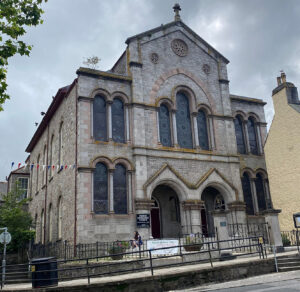
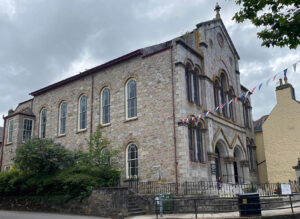
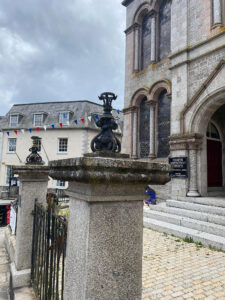
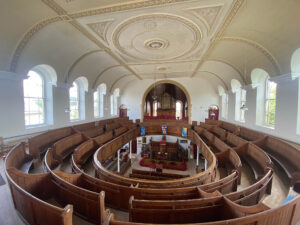
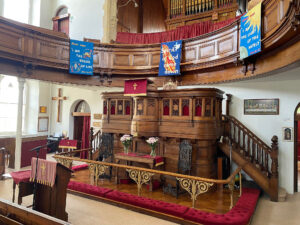

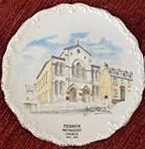
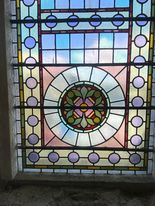
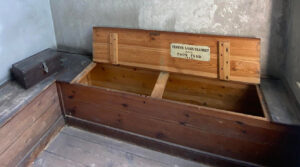 Pentyn Loan Blanket and Poor Fund boxes
Pentyn Loan Blanket and Poor Fund boxes
